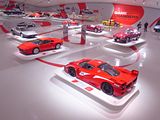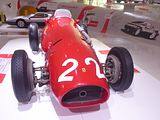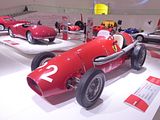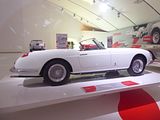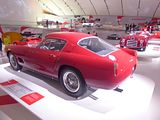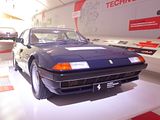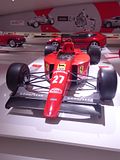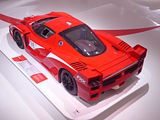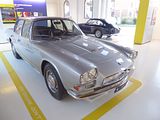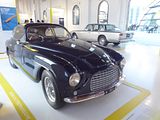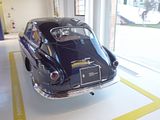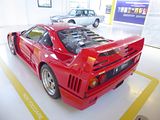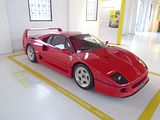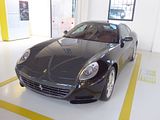Although it has been open for more than ten years now, the Museo Casa Enzo Ferrari, located in the centre of Modena, still has to play second fiddle to the better known, longer established and far more visited Galleria Ferrari which is in Maranello. That one is world famous, attracting vast crowds of visitors including lots of coach parties, but if tiosi and other enthusiasts only visit Maranello, then they really are missing out as the Modena site is just as worth visiting. This additional Ferrari museum provides not just a place to show more of the incredible cars and artefacts from the company’s history, but it is also significant as it is located not just in the city where Enzo was born in 1898, but because it includes the building that constituted his father’s workshop. This has been restored on the outside and completely refitted on the inside to allow for a lot of display space. A new and rather striking building was constructed alongside it, and this houses the main part of the museum, as well as the expected cafe and gift shop. The site is in the middle of the town, a few hundred yards from the Maserati factory, and easily accessible from the A1 autostrada which goes from Bologna west to Milano, as well as being a matter of a few metres from Modena railway station. The emphasis here is on quality rather than quantity, with around 18 vehicles beautifully displayed in the annex that was built as part of the reopening of the site in 2012, and the adjoining and older building, once the Ferrari family workshop, contains mainly a series of historic Ferrari engines, along with a few further race cars. Since that 2012 opening, the displays have been changed more or less on an annual basis, so it this is one of those museums that it is well worth returning to whenever in the area, as I have done on an annual basis since 2014. The only exception being 2021, as the displays that were set up in 2020 just before lockdown persisted for both 2020 and 2021. The changeover point is usually in the first few weeks of the year, and when I was planning a visit to Italy for early March 2023, I did check and found that a new display in the main building was opened in the middle of February. This one is called “Game Changers” and deciding what to display must have ben as hard as many of the other themes from the preceding ten, but the idea is to showcase some of the particularly significant cars from the marque’s 75 year history, with a mix of road and race cars included. Here is what has been chosen:
166MM: The Ferrari 166 S was a sports racing car built by Ferrari between 1948 and 1953, an evolution of its Colombo V12-powered 125 S racer. It was adapted into a sports car for the street in the form of the 166 Inter. Only 12 Ferrari 166 S were produced, nine of them with cycle-fenders as the Spyder Corsa. It was soon followed by the updated and highly successful Ferrari 166 MM (Mille Miglia), of which 47 were made from 1948 to 1953. Its early victories in the Targa Florio and Mille Miglia and others in international competition made the manufacturer a serious competitor in the racing industry. Both were later replaced by the 2.3 L 195 S. The majority of the 166MM cars were bodied by Touring in Barchetta form.
125S: Although preceded by Enzo Ferrari’s Auto Avio Costruzioni 815 of 1940, the 125 S was the first vehicle to bear the Ferrari name when it debuted on May 11, 1947 at the Piacenza racing circuit. Like the 815, it was a racing sports car, but unlike its Fiat-powered 8-cylinder predecessor, the 125 S featured a V12 engine (the “125”), a trait it shared with most Ferrari cars of the following decades. Only 2 were built before the 125 S would be replaced by the 159 S later in the year. The 125 S used a steel tube-frame chassis and had a double wishbone suspension with transverse leaf springs in front with a live axle in the rear. Hydraulic power drum brakes were specified front and rear. It was powered by Gioacchino Colombo’s 1497 cc 60° V12, which produced 118 bhp at 6,800 rpm . This was a single overhead camshaft design with 2 valves per cylinder and three double-choke Weber 30DCF carburettors. Enzo Ferrari wanted the 125 S to use a five-speed gearbox as it matched the high revving V12 better than that of a traditional four-speed gearbox. The 125 S debuted at the Circuito di Piacenza, driven by Franco Cortese, but was unable to finish the race, despite a favourable showing against the strong Maserati 6CS 1500s. Two weeks later, the 125 S claimed Ferrari’s first victory at the Grand Prix of Rome on the Terme di Caracalla Circuit, where it was also driven by Cortese. The car had spun a bearing in practice, and was repaired in the workshop of Tino Martinoli, who later came to America with the Ferrari Indy car team. The 125 S won six of its fourteen races in 1947, though drivers Clemente Biondetti and Giuseppe Navone were unable to win the 1947 Mille Miglia in it. Both of the two 125 S cars built in 1947 were dismantled, and their parts are thought to have been re-used in production of the 159 or 166 models. Recently, the chassis with serial number 010I was used in the restoration of a 125 S. It is rumoured that 010I is actually s/n 01C. The story goes that 01C was re-stamped as 010I, and sold to a customer as a new car. Upon taking receipt of the car, the new owner immediately exclaimed, muletto!, which means “Test mule” in Italian, as he could clearly see that his supposedly new car was in fact a used, well-raced car. Ferrari made a new invoice for the car, including a considerable rebate given the car’s second-hand nature. Still in 166 Spyder Corsa configuration, the car was sold to Symbolic Motors. Close inspection of the chassis and its serial number led to the discovery of an old stamping that could possibly read 01C. It had been covered by an aluminium plate which bore the serial number 010I. Subsequently, the car was sold to its current owner, who refitted the chassis with a body similar to the factory’s 125 S replica, which was built by Michelotto in 1987. The alleged 01C made its public debut at the Pebble Beach Concours d’Elegance, and was entered as a “Ferrari 125 S”. The car continues to be the subject of much debate among Ferrari historians and enthusiasts; recent developments indicate that the restamped serial number was in fact a correction and not an alteration.
500 F2: the Ferrari 500 was a Formula 2 racing car designed by Aurelio Lampredi and used by Ferrari in 1952 and 1953, when the World Championship was run to F2 regulations. For 1952, the FIA announced that Grand Prix races counting towards the World Championship of Drivers would be run to Formula 2 specification rather than to Formula 1, after the withdrawal of Alfa Romeo from the sport. Ferrari were the only team to have a car specifically designed for the new formula. The car was powered by an inline four-cylinder engine which was mounted behind the front axle, improving weight distribution. Alberto Ascari used the car to win his first world championship, winning all but one race with the simple 500. The race he missed was because he was driving the 4.5-litre Ferrari at the Indianapolis 500, however Ferrari won the race he was absent from as well. The following season, Ascari won his second world championship, and Ferrari won all but the final race, which was won by Juan Manuel Fangio, back in racing after an accident which had damaged his neck. Ascari won seven consecutive World Championship races in the 500, a record which stood until Sebastian Vettel broke it in 2013. If the 1953 Indianapolis 500 (which was run to a different formula, and in which Ascari was not entered) is discounted, the run is extended to nine. For the 1954 season and the return to Formula One engine regulations, Ferrari 500 chassis were modified for the new regulations with the 2.5-litre 625 engine and would win two more races, one each in 1954 and 1955, although it was not quite fast enough compared to the Mercedes-Benz W196 and Maserati 250F.
250 GT Spider: Designed for export to North America, the 1957 250 GT California Spyder was Scaglietti’s interpretation of an open-top 250 GT. Aluminium was used for the bonnet, doors, and boot lid, with steel elsewhere for most models. Several aluminium-bodied racing versions were also built. The engine was the same as in the 250 Tour de France racing car with up to 240 PS @ 7000 rpm and a maximum torque of 195 lb/ft @ 5000 rpm, from a 2,953 cc naturally aspirated SOHC 2 valves per cylinder 60º Ferrari Colombo V12 engine, equipped with 3 Weber carburettors. All used the long 2,600 mm (102.4 in) chassis, and Pirelli Cinturato 185VR16 tyres (CA67) were standard. A total of fifty LWBs were made before the SWB version superseded them in 1960. One example sold at auction on August 18, 2007 in Monterey, California, for $4.9 million.
250 Tour de France: The original 250 GT Berlinetta, nicknamed the “Long Wheelbase Berlinetta”, was also called the “Tour de France” after competing in the 10-day Tour de France automobile race, which the car won in 1956, 157 and 1958. Seventy-seven Tour de France cars were built, of which a number were sold for GT races from 1956 through 1959. Construction was handled by Carrozzeria Scaglietti based on a Pinin Farina design. The engine began at 240 PS but eventually rose to 260 PS. Pirelli Cinturato 165R400 tyres (CA67) were standard. At the 1956 Geneva Motor Show, Scaglietti displayed their own 250 GT prototype, which became known as the limited-production, Series I, “no-louvre” 250 GT Berlinetta. The first customer car was built in May 1956, with production now the responsibility of Scaglietti in Modena. Fourteen “no-louvre” and nine “14-louvre” Series I and II Berliettas were made. There were four series of 250 GT Berlinettas. In mid-1957 the Series III cars were introduced, with three louvres and covered headlights. Eighteen were produced. The 36 Series IV cars; retained the covered headlights and had a single vent louvre. Zagato also made five “no-louvre” superlight cars to Ugo Zagato’s design.
410 SuperAmerica: Recognising the ever increasing importance of America for sales, Ferrari produced a line of America cars, beginning with the 1955 410 Superamerica. The engine, based on a single plug 410 S powerplant, was now up to 5.0 L with 340 PS (335 bhp) at 6,000 rpm produced thanks to triple Weber 40DCF carburettors. A 1957 Superamerica series III had triple 46DCF3 Webers for even more power (360 PS (355 bhp)) and was also the final development for the ‘long-block’ Lampredi V12. Each 410 Superamerica had custom bodywork, with a few by Boano and Ghia but most by Ferrari stalwart, Pinin Farina. The price was extremely high—at US$16,800, the 410 Superamerica offered at the New York Auto Show by importer Luigi Chinetti was more than twice as expensive as the Mercedes-Benz 300SL “Gullwing” exhibited by Max Hoffman. Just 35 were built when the series ended in 1959. First 2 series of Pinin Farina coupés were very similar with only 3rd series radically redesigned with non-panoramic rear window, different side-line, lower front grille and more recessed headlights, some covered. While most 3rd series PF coupés had 3 louvres behind side-windows, some have this space glassed over. Series III cars were introduced in 1958.
250 GT Coupe: Needing series production to stabilize his company’s finances, Enzo Ferrari asked Pininfarina to design a simple and classic 250 GT coupé. After the 250 GT Boano/Ellena, Pininfarina’s Grugliasco plant expanded and now had the capacity to produce the new 250 GT Coupé Pininfarina. It was introduced at Milan in 1958, and 335 near-identical examples were built by 1960. Buyers included Prince Bertil of Sweden. The GT Coupé eschewed the fender vents for simple, clean lines and a notchback look with panoramic rear window. The oval grille was replaced by a more traditional long narrow look with protruding headlights. Telescopic shock absorbers were also fitted instead of the Houdailles on previous 250s, and disc brakes were added in 1960. The original 165R400 Pirelli Cinturato tyres (CA67) were later changed to 185VR16. The final 250 GT Coupé had a Superfast tail and was shown at the 1961 London Motor Show. In line with the high-volume coupé, Pinin Farina also designed a plainer 250 GT Cabriolet for series production. Introduced at the 1959 Paris Motor Show, the GT Spider sported a look similar to the GT Coupé of the previous year, including the removal of the side vents. 185VR15 Pirelli Cinturato tyres (CA67) were standard. On the Coupé the headlights were uncovered. About 212 were produced. In line with the high-volume coupé, Pinin Farina also designed a plainer 250 GT Cabriolet for series production. Introduced at the 1959 Paris Motor Show, the GT Spider sported a look similar to the GT Coupé of the previous year, including the removal of the side vents. 185VR15 Pirelli Cinturato tyres (CA67) were standard. On the Coupé the headlights were uncovered. About 212 were produced.
250 GT/E: No fewer than 18 different models were made with the 250 designation, with new versions being seen every few months. The LWB 250 GT theme was expanded with a 2+2 model called the 250 GT/E. The first large production four-seat Ferrari (earlier four seaters were made in very small numbers), this model offered greater interior space by moving the engine forward in the chassis. The rear seats were ideal for children but rather tight for adults. Engine output was listed at 237 bhp, making it a very rapid four seater indeed. Almost 1,000 GT/Es were constructed by Pininfarina with prototypes starting in 1959 and continuing through three series until 1963. The model was followed by the visually similar 330 Americas. The large production run of the GT/E was a major contributor to the financial well being of Ferrari in the early 1960s. In recent times many of them have had their bodies removed, so the chassis can be used for replica versions of other models from the 250 lineup, but people are now realising that these cars are attractive in their own right and the trend appears to have stopped.
365 GT4/BB: Production of the Berlinetta Boxer was a major step for Enzo Ferrari. He felt that a mid-engined road car would be too difficult for his buyers to handle, and it took many years for his engineers to convince him to adopt the layout. This attitude began to change as the marque lost its racing dominance in the late 1950s to mid-engined competitors. The mid-engined 6- and 8-cylinder Dino racing cars were the result, and Ferrari later allowed for the production Dino road cars to use the layout as well. The company also moved its V12 engines to the rear with its P and LM racing cars, but the Daytona was launched with its engine in front. It was not until 1970 that a mid-engined 12-cylinder road car would appear.The first “Boxer” was the 365 GT4 BB shown at the 1971 Turin Motor Show. Designed to rival the Lamborghini Miura and the newly developed Lamborghini Countach, it was finally released for sale in 1973 at the Paris Motor Show. 387 were built, of which 88 were right-hand drive (of which 58 were for the UK market), making it the rarest of all Berlinetta Boxers. The Pininfarina-designed body followed the P6 show car with popup headlights. Though it shared its numerical designation with the Daytona, the Boxer was radically different. It was a mid-engined car like the Dino, and the now flat-12 engine was mounted longitudinally rather than transversely. Although referred to as a Boxer, the 180° V12 was not a true boxer engine, but rather a flat engine. It had 380 hp, slightly more than the Daytona. The 365 GT4 BB was updated as the BB 512 in 1976, resurrecting the name of the earlier Ferrari 512 racer. The name 512 referred to the car’s 5 litre, 12 cylinder engine; a deviation from Ferrari’s established practice of naming 12-cylinder road cars (as the 365 BB) after their cylinder displacement. The engine was enlarged to 4943.04 cc, with an increased compression ratio of 9.2:1. Power was slightly down to 360 hp, while a dual plate clutch handled the added torque and eased the pedal effort. Dry sump lubrication prevented oil starvation in hard cornering. The chassis remained unaltered, but wider rear tires (in place of the 365’s equally sized on all four corners) meant the rear track grew 63 mm. External differentiators included a new chin spoiler upfront, incorporated in the bumper. A NACA duct on the side provided cooling for the exhaust system. At the rear there were now twin tail lights and exhaust pipes each side, instead of triple units as on the 365 GT4 BB. 929 BB 512 models were produced. The Bosch K-Jetronic CIS fuel injected BB 512i introduced in 1981 was the last of the series. The fuel injected motor produced cleaner emissions and offered a better balance of performance and daily-driver temperament. External differentiators from the BB 512 besides badging include a change to metric sized wheels and the Michelin TRX metric tyre system, small white running lights in the nose, and red rear fog lamps outboard of the exhaust pipes in the rear valance. 1,007 BB 512i models were produced.
400GT: Ferrari offered a V12 engined four-seater model for most of the 70s and 80s. of which this 400GT is an example. The car started out as the 365 GT4 2+2 and was first seen in 1972. The car was updated, to become the 400GT at the 1976 Paris Motor Show. It proved quite controversial, as this was the first Ferrari to be offered with an automatic gearbox, a Borg Warner 3-speed unit, though a five speed manual was also offered. The 365’s V12 engine had been stroked to a displacement of 4.8 litres and given six 38 DCOE 110-111 Webers, and now produced 340 PS. 0-60 mph took 7.1 seconds. Other changes compared to the 365 GT4 included five-stud wheels to replace the knock-off hubs (Borrani wheels weren’t offered anymore), a revised interior, the addition of a lip to the front spoiler, and double circular tail light assemblies instead of triple. A total of 502 examples were produced, 355 of which were Automatics and 147 GTs before a further upgrade in 1979 which saw the addition of fuel injection. It was replaced by the visually similar 412i in 1985. which had a larger 5 litre engine. Production of this version ran for 4 years, meaning that by the time the model was deleted from the range, this elegant Pininfarina design had been produced for 17 years, the longest run of any Ferrari bodystyle ever. It was some years before another 4 seater V12 Ferrari would join the range, the 456 GT in 1994.
288 GTO: First of the series of special hypercars that Ferrari has produced roughly once a decade, and still my personal favourite, was the 1984 288 GTO. The GTO was built to compete in the new Group B Race series and a minimum of 200 cars were required for homologation. However, after the death of Henri Toivonen and his co-driver Sergio Cresto in the 1986 Tour de Corse, the FIA disestablished the class, leaving just the Group A Rally championship. As a result, the GTO never raced and all 272 cars built remained purely road cars. Some of the GTO’s styling features were first displayed on a 308 GTB design exercise by Pininfarina shown at the 1977 Geneva Salon. The 288 GTO started out as a modified version of the 308/328 to hold down costs and to build the car quickly, but little of the 308/328 was left when the 288 GTO was finished. Easily noticeable differences were the GTOs bulging wing flares, larger front/rear spoilers, large “flag-style” outside mirrors and four driving lights at the far sides of the grille. Retained from the original 250 GTO were slanted air vents, put in the GTO’s rear wings to cool the brakes. The GTO also had wider body panels than the 308’s because they had to cover much larger Goodyear tyres mounted on racing wheels. The suspension’s height could be set higher for road use and lower for racing on tracks. Bodywork material was new and lighter for better acceleration and handing. The GTO’s weight was only 2,555 pounds, compared to 3,085-3,350 for the 308/328. Steel was used just for the doors because major body panels were made from moulded fibreglass. Kevlar was used for the engine cover, and the roof was made from Kevlar and carbon fibre. The “288” refers to the GTO’s 2.8 litre V8 engine as it used a de-bored (by 1 mm) V8 with twin IHI turbochargers, intercoolers, and Weber-Marelli fuel injection. The 2855 cc engine capacity was dictated by the FIA’s requirement for a Turbocharged engine’s capacity to be multiplied by 1.4. This gave the GTO a theoretical engine capacity of 3997 cc, just under the Group B limit of 4.0 litres. Unlike the 308’s 2926 cc engine, the GTO’s 2855 cc engine was mounted longitudinally, using the 308’s rear boot space. This was necessary to make room for the twin turbochargers and intercoolers. The racing transmission was mounted to the rear of the longitudinal engine, moving the rear differential and wheels aft. The arrangement also let the GTO use a more conventional race-car engine/transmission layout for such things as quick gear ratio changes for various tracks. As a result, the wheelbase was 110 mm (4.3 in) longer at 2,450 mm (96 in). The track was also widened to accommodate wider wheels and tyres to provide increased cornering and braking performance and the ability to apply 400 hp and 366 lb·ft of torque to the ground. The GTO was an impressive performer, with 0-60 mph times around 5 seconds. Ferrari claimed 0-125 mph (201 km/h) in 15 seconds flat and a top speed of 189 mph (304 km/h), making it the first street-legal production car to reach 300 km/h.
408 4RM Prototipo: The Ferrari 408 4RM is a prototype car built by Ferrari in 1987. It was the first Ferrari to feature 4-wheel drive. The 408 4RM featured a hydraulic four-wheel-drive system developed by Ferrari, and was the first Ferrari to feature 4-wheel drive. In 1991, Ferrari deemed that the system was not suited to the company’s philosophy, stating that it increased the weight of the car by 200 kg (441 lb). The 408 remained as the only Ferrari to use 4-wheel drive until the Ferrari FF, introduced in 2011, which became the first production Ferrari with 4 wheel drive. The FF also uses a system called “4RM”, which is said to be more technologically advanced and lighter than the system in the 408, and it is unclear whether it shares any of its design with the 408. The first 408 4RM was red, s/n 70183. Two copies were built, based on a design by I.DE.A Institute. The first one, chassis no. 70183, was painted in red and was fitted with an all-steel welded chassis and was built in June 1987. The second one, chassis no 78610, was painted yellow and had an aluminum frame bonded with adhesives. The second car was completed in September 1988 and has been exhibited at the Galleria Ferrari in Maranello. The model name was linked to the characteristics of the engine, with the 40 in 408 standing for its 4.0 L displacement, and the 8 representing the number of cylinders. The abbreviation “4RM” stood for “4 Ruote Motrici”, meaning four-wheel drive.
640 (F1-89): The Ferrari 640 (also known as the Ferrari F1-89) was the Formula One racing car with which the Ferrari team competed in the 1989 season. It was driven by Britain’s Nigel Mansell, in his first season with the team, and Austria’s Gerhard Berger. The car was designed by John Barnard, and it was the first Ferrari he was responsible for designing. It sported a sharp nose, with a narrow monocoque and bulging side-pods designed to house the radiators with maximum aerodynamic efficiency. It originally had two small air intakes either side of the driver, but from the fourth race of the season in Mexico a more conventional large air intake above and behind the driver was specified. Barnard, who had joined Ferrari from McLaren at the end of the 1986 season, had begun designing the car in 1987 with the intent on it being used during the 1988 season. However, continual problems with the car’s revolutionary semi-automatic gearbox saw the team forced to use the turbocharged F1/87/88C in 1988, with the car’s debut pushed back to 1989, the first year of FISA’s 3.5 Litre atmospheric formula where turbos were banned. The 640 was powered by Ferrari’s Tipo 035/5, a 3.5 litre V12 engine which produced up to 660 bhp by the season end, roughly the same amount of power as the engine it replaced, the Tipo 033A V6 turbo, though without the turbo’s fuel consumption worries. This was still down compared to the V10 Honda used by the dominant McLarens which were rated at 675 bhp. The transmission to which it was mated, however, attracted more attention, as it contained the very first semi-automatic gearbox seen in Formula One. In the first half of the season, it proved to be very unreliable, and hampered Ferrari’s efforts. However, such gearboxes would become the norm by the mid-1990s. Much of the development work was conducted at Ferrari’s private test track Fiorano by test driver Roberto Moreno during the winter season (Moreno also doubled as the lead driver of the small, cash-strapped Coloni team). By the time the Grand Prix circus returned to Europe at the end of June, the problem with the semi-automatic gearbox was found to be not enough power from the battery. With the help of electrical experts from team sponsor Magneti Marelli, the power supply to the gearbox was fixed and the 640’s reliability rose accordingly. The car proved to be fast, and Mansell took it to victory in its début race in Brazil, despite fears of unreliability (the potential of the new car, with its innovative aerodynamics, gearbox and V12 engine was clear – Mansell declared on the eve of the Brazilian race that if “the car had even half the horsepower it sounds like it has, we’ll win every race this year…”). However, it did not record another finish until the French Grand Prix, and there were to be no races in which both drivers finished. But when the car did finish, it did so in a position no lower than third, with Mansell taking second in both France and his home race at Silverstone, third in Germany where the long straights saw the Ferrari V12 almost breathless against the more powerful Honda V10s (though they still had the advantage over the Renault V10s of Williams and the Ford V8 powered Benettons), a second win in Hungary which was highlighted by his passing move on Senna to take the lead, and finally third at Spa, before Berger finished second at Monza, won in Portugal – a race where the Ferraris were clearly more competitive than the championship-winning McLarens – and finished second again in Spain. The carbon fibre monocoque also proved to be very strong, allowing Berger to escape from a fiery high-speed crash at Imola with only minor burns to his hands and a couple of broken ribs. In a 2013 interview, Berger revealed the reason for the crash was the front wing had broken on the car, though as the right front wheel had risen his initial thought was rear suspension failure or a flat left rear tyre. He then revealed that even in the short time it took from the car not responding to the time it hit the wall, he also realised the car was almost full of fuel and could catch fire. From then he was briefly knocked unconscious, but was awake and aware only a minute or so later. Berger’s injuries were enough to keep him out of the Monaco Grand Prix, but with the help of Niki Lauda’s physical therapist Willy Dungl, and the semi-automatic gearbox’s advantage of not having to take his hands off the steering wheel to change gears, the brave Austrian was able return one race later in Mexico where his injuries would otherwise have kept him out if the 640 had used a conventional gearbox and stick shift. According to Barnard, he had been searching for a way to eliminate the old manual transmission in racing cars since he had designed the Chaparral 2K that had taken Johnny Rutherford to victory in the 1980 Indianapolis 500. This was purely from an aerodynamic perspective as the manual transmission (usually located on the drivers right hand side) had meant that a car’s monocoque had to be wider than desirable to accommodate the stick shift and its link to the gearbox located at the rear of a car. The semi-automatic transmission with its paddle shift located behind the steering wheel, along with a hydraulically operated clutch, had eliminated the need for this and had allowed Barnard to design the Ferrari with its distinctive sharp nose. At the end of the season, Mansell was fourth in the Drivers’ Championship with 38 points, while Berger was seventh with 21. Berger, 3rd in the 1988 Drivers’ Championship, only finished 3 races during the season and retired from 10 of the first 11 races (missing Monaco). His first points came in Round 12 at Monza with a second place before winning in Portugal and finishing 2nd again in Spain. Ferrari battled with Williams for second in the Constructors’ Championship for much of the year but ultimately settled for third, with 59 points. Ferrari lost 2nd in the Constructors’ Championship when both Mansell and Berger failed to finish the final two races of the year in Japan and Australia, while both Williams drivers finished second and third at Suzuka, and first and third in Adelaide. For the 1990 season, the 640 was replaced with the 641.
FXX: The FXX is based on the street-legal flagship Enzo Ferrari. Production of the FXX began in 2005. The FXX uses some technology demonstrated on the Enzo Ferrari and combines it with new developments from Ferrari and its suppliers. However, the car is only a part of the overall FXX program. Customers pay GB£2 million, but are only allowed to drive the car on special track days which are approved by Ferrari. After they drive the car, the owners are entitled to be debriefed by Ferrari on the car’s performance. Ferrari’s sister company Maserati, has developed a similar car, the MC12 Versione Corsa for this purpose with the only difference being that the owners can keep the car in their custody. Lamborghini also allows their track-day car, the Essenza SCV12, to be kept by the custody of their customers. The FXX may be stored by owners wherever they please. The caveat behind the FXX is only that Ferrari technicians must look over the car “before the car hits the track in any event or private testing session.” The FXX, an evolution of the Enzo in essence, shares some components with the flagship car, but numerous significant developments are unique to the FXX. The FXX’s engine is based on Enzo’s, but displacement has been increased to 6,262.45 cc from 5,998 cc. Power output has been raised from the Enzo’s 660 PS (651 bhp) at 7,800 rpm, to 800 PS (789 bhp) at 8,500 rpm. The gearbox incorporates the latest developments from Ferrari’s Formula One program and has a shift time of under 100 milliseconds. The brake pads were also upgraded from the Enzo. It does, however, retain the Carbon fibre-reinforced Silicon Carbide (C/SiC) ceramic composite brake discs featured on the Enzo. The tyres are custom-developed 19 inch racing slicks. The FXX has comprehensive data-monitoring and telemetry systems that not only allow the driver to assess their performance on the track, but also provide Ferrari technicians with valuable data to improve the car and future road-going Ferrari models. Ferrari has built 30 cars in total, adding one special edition to the 29 cars that were originally planned. The original 29 cars have all been sold to pre-selected past Ferrari customers. The 30th car was retained by Ferrari S.p.A. and presented to Ferrari’s Formula One World Champion driver, Michael Schumacher, along with an Enzo Ferrari when he retired from Formula One racing at the end of 2006 as a token of appreciation for his achievements. Schumacher’s FXX differs from others in having black paintwork without stripes, having red trimmed wheels, matte rather than chrome exhaust tips, and his personal logo stitched on the racing seats. The owners of the FXX also participate in Ferrari’s testing and brand development programs. The purpose of this particular program is to allow Ferrari’s top customers exclusive access to its most up-to-date technology and to utilise their input in the development of future models. The model was only sold in Europe. Units can be imported, but not owned, on any other continent. A more aggressive FXX Evoluzione package was introduced in 2009 and was reported to cost €1.5 million (excluding taxes) including the car, the crew and the services provided by Ferrari.
FF: The Ferrari FF (FF meaning “Ferrari Four”, for four seats and four-wheel drive, the Type F151) is a grand tourer presented by Ferrari on March 1, 2011 at the Geneva Motor Show as a successor to the 612 Scaglietti and is Ferrari’s first production four-wheel drive model. The body style has been described as a shooting-brake, a type of sporting hatchback/estate car with two doors. With a top speed of f 335 km/h (208 mph) and it accelerates from 0 to 100 km/h (62 mph) in 3.7 seconds, Ferrari stated that the FF was the world’s fastest four-seat automobile upon its release to the public. At the time of its reveal, the Ferrari FF had the largest road-going Ferrari engine ever produced: an F140 EB 6,262 cc naturally aspirated direct injected 65° V12, which produced 660 PS (485 kW; 651 hp) at 8,000 rpm and 683 N⋅m (504 lb⋅ft) of torque at 6000 rpm. The FF is equipped with a 7-speed dual-clutch transmission and paddle shift system similar to the California, the 458 Italia, and the Ferrari F12berlinetta. The new four-wheel drive system, engineered and patented by Ferrari, is called 4RM: it is around 50% lighter than a conventional system, and provides power intelligently to each of the four wheels as needed. It functions only when the manettino dial on the steering wheel is in the “comfort” or “snow” positions, leaving the car most often in the traditional rear wheel drive layout. Ferrari’s first use of 4RM was in a prototype created in the end of the 80s, called 408 4RM (abbreviation of “4.0 litre, 8 cylinder, 4 Ruote Motrici”, meaning “four-wheel drive”). This system is based around a second, simple, gearbox (gears and other components built by Carraro Engineering), taking power from the front of the engine. This gearbox (designated “power take off unit”, or PTU) has only two forward gears (2nd and 4th) plus reverse (with gear ratios 6% taller than the corresponding ratios in the main gearbox), so the system is only active in 1st to 4th gears. The connection between this gearbox and each front wheel is via independent Haldex-type clutches, without a differential. Due to the difference in ratios “the clutches continually slip” and only transmit, at most, 20% of the engine’s torque. A detailed description of the system (based on a conversation with Roberto Fedeli, Ferrari’s technical director) has been published. The FF shares the design language of contemporary Ferraris, including the pulled-back headlights of the 458 Italia, and the twin circular taillights seen on the 458 as well as the 599 GTB Fiorano. Designed under the direction of Lowie Vermeersch, former Design Director at Pininfarina, and Flavio Manzoni, Ferrari’s Styling Centre, work on the shooting brake concept initially started following the creation of the Sintesi show car of 2007. Distinctive styling elements include a large egg-crate grille, defined side skirts, and four exhaust tips. The shooting brake configuration is a departure from the conventional wedge shape of modern Ferraris, and the FF has been likened to the similarly-shaped 1962 Ferrari 250 GT SWB Drogo race car. The combination of hatchback-like shooting-brake design and collapsible rear seats gives the Ferrari FF a boot capacity of between 16 and 28 cu ft. Luxury is the main element of the interior and the use of Leather is incorporated throughout, just like the predecessors of the FF. Creature comforts like premium air conditioning, GPS navigation system, carpeting and sound system are also used. An updated version. called the GTC4 Lusso was launched in 2016 by which 2291 examples had been built.
Purosangue: Perhaps because this is a brand new model, not yet out on the roads, this car was the one which was attracting the most attention and of which the largest number of selfies were being taken. Ferrari have finally caved in and made their first SUV and given the huge (and profitable) success of models like the Urus and Bentayga, the business case can’t have been that hard to approve!
296 GTB: The only way to get close up shots of this, the latest of the “entry level” sports cars was to have the official photographer take your picture, and if you tried to take your own, the security guard warned you off pretty quickly, but there was nothing to stop a shot from the walkways around the side of the museum!
The displays in the second building, the restored Ferrari workshop, had not changed since my last visit. These included cars from a number of former themes over the past ow 11 years since the opening of the museum.
Maserati Quattroporte 1: The original Maserati Quattroporte (Tipo AM107) was built between 1963 and 1969. It was a large saloon powered by V8 engines—both firsts for a series production Maserati. The task of styling the Quattroporte was given to Turinese coachbuilder Pietro Frua, who drew inspiration from a special Maserati 5000 GT (chassis number 103.060) he had designed in 1962 for Prince Karim Aga Khan. While the design was by Frua, body construction was carried out by Vignale. The Quattroporte was introduced at the October-November 1963 Turin Motor Show, where a pre-production prototype was on the Maserati stand next to the Mistral coupé. Regular production began in 1964. The Tipo 107 Quattroporte joined two other grand tourers, the Facel Vega and the Lagonda Rapide, capable of travelling at 200 km/h (124 mph) on the new motorways in Europe. It was equipped with a 4.1-litre V8 engine, producing 260 hp at 5,000 rpm, and either a five-speed ZF manual transmission or a three-speed Borg Warner automatic on request. Maserati claimed a top speed of 230 km/h (143 mph). The car was also exported to the United States, where federal regulations mandated twin round headlamps in place of the single rectangular ones found on European models. Between 1963 and 1966, 230 units were made. In 1966, Maserati revised the Tipo 107, adding the twin headlights already used on the U.S. model. A leaf-sprung solid axle took place of the previous De Dion tube. The interior was completely redesigned, including the dashboard which now had a full width wood-trimmed fascia. In 1968 alongside the 4.1-litre a 4.7-litre version became also available (AM107/4700), developing 286 bhp. Top speed increased to a claimed 255 km/h (158 mph), making the Quattroporte 4700 the fastest four-door sedan in the world at the time. Around 500 of the second series were made, for a total of 776 Tipo 107 Quattroportes. Production ended in 1969
166 Inter Touring: The Ferrari 166 Inter was Ferrari’s first true grand tourer. An evolution of the 125 S and 166 S racing cars, it was a sports car for the street with coachbuilt bodies. The Inter name commemorated the victories claimed in 166 S models by Scuderia Inter. 38 166 Inters were built from 1948 through 1950. Note that both the 166 S and 166 F2 were also called “166 Inter” in the days that they were actively raced by the Scuderia of the same name. The 166 Inter shared its Aurelio Lampredi-designed tube frame, double wishbone/live axle suspension, and 2,420 mm (95.3 in) wheelbase with the 125 S and 166 S. It was replaced by the 2.3 L 195 Inter in 1950. The first Ferrari GT car debuted at the Paris Motor Show on October 6, 1949. It was an elegant coupé designed by Carrozzeria Touring of Milan who had previously created a number of similar Ferrari and Alfa Romeo models. Customer sales soon started, with 166 Inter models becoming the first Ferraris to be purchased for the road rather than the race track. As was typical at the time, a bare chassis was delivered to the coachbuilder of the customer’s choice. Majority used Touring with coupé or barchetta style. Carrozzeria Ghia produced one-off coupé designed by Felice Mario Boano. Others were built by Stabilimenti Farina, who penned coupés and cabriolets. Bertone bodied one cabriolet. Vignale also joined in with seven bodyworks, presaging their designs of the coming decade, foreshadowed those companies’ later involvement with Ferrari. The 2.0 L Gioacchino Colombo-designed V12 engine from the 166 S remained, as did its chassis, though the wheelbase would eventually grow from 2,420 mm (95.3 in) to 2,500 mm (98.4 in) and even 2,620 mm (103.1 in). Output was 90 PS at 5600 rpm with one carburetor and top speed of 150 km/h (93 mph). Just 38 of these cars were built.
F40: The F40 of 1987 was the successor to the 288 GTO. It was designed to celebrate Ferrari’s 40th anniversary and was the last Ferrari automobile personally approved by Enzo Ferrari. At the time it was Ferrari’s fastest, most powerful, and most expensive car for sale. As soon as the 288 GTO was launched, Ferrari started the development of an evolution model, intended to compete against the Porsche 959 in FIA Group B. However, when the FIA brought an end to the Group B category for the 1986 season, Enzo Ferrari was left with five 288 GTO Evoluzione development cars, and no series in which to campaign them. Enzo’s desire to leave a legacy in his final supercar allowed the Evoluzione program to be further developed to produce a car exclusively for road use. In response to the quite simple, but very expensive car with relatively little out of the ordinary being called a “cynical money-making exercise” aimed at speculators, a figure from the Ferrari marketing department was quoted as saying “We wanted it to be very fast, sporting in the extreme and Spartan,” “Customers had been saying our cars were becoming too plush and comfortable.” “The F40 is for the most enthusiastic of our owners who want nothing but sheer performance. It isn’t a laboratory for the future, as the 959 is. It is not Star Wars. And it wasn’t created because Porsche built the 959. It would have happened anyway.” Power came from an enlarged, 2936 cc version of the GTO’s twin IHI turbocharged V8 developing 478 bhp. The F40 did without a catalytic converter until 1990 when US regulations made them a requirement for emissions control reasons. The flanking exhaust pipes guide exhaust gases from each bank of cylinders while the central pipe guides gases released from the wastegate of the turbochargers. Engines with catalytic converters bear F120D code. The suspension was similar to the GTO’s double wishbone setup, though many parts were upgraded and settings were changed; the unusually low ground clearance prompted Ferrari to include the ability to raise the vehicle’s ground clearance when necessary. The body was an entirely new design by Pininfarina featuring panels made of Kevlar, carbon fibre, and aluminium for strength and low weight, and intense aerodynamic testing was employed. Weight was further minimised through the use of a plastic windscreen and windows. The cars did have air conditioning, but had no sound system, door handles, glove box, leather trim, carpets, or door panels. The first 50 cars produced had sliding Lexan windows, while later cars were fitted with wind down windows. The F40 was designed with aerodynamics in mind. For speed the car relied more on its shape than its power. Frontal area was reduced, and airflow greatly smoothed, but stability rather than terminal velocity was a primary concern. So too was cooling as the forced induction engine generated a great deal of heat. In consequence, the car was somewhat like an open-wheel racing car with a body. It had a partial undertray to smooth airflow beneath the radiator, front section, and the cabin, and a second one with diffusers behind the motor, but the engine bay was not sealed. Nonetheless, the F40 had an impressively low Cd of 0.34 with lift controlled by its spoilers and wing. The factory never intended to race the F40, but the car saw competition as early as 1989 when it debuted in the Laguna Seca Raceway round of the IMSA, appearing in the GTO category, with a LM evolution model driven by Jean Alesi, finishing third to the two faster space-framed four wheel drive Audi 90 and beating a host of other factory backed spaceframe specials that dominated the races. Despite lack of factory backing, the car would soon have another successful season there under a host of guest drivers such as Jean-Pierre Jabouille, Jacques Laffite and Hurley Haywood taking a total of three second places and one third. It would later be a popular choice by privateers to compete in numerous domestic GT series. Although the original plan was to build just 400 cars, such was the demand that in the end, 1311 were built over a 4 year period.
612 Scaglietti: Follow on to the 456GT was the 612 Scaglietti. Launched in 2004, this large 4 seater would be produced until 2011 when it was replaced by the FF. It never quite hit the spot for many people and the fact that Ferrari made few changes to it during its life makes you wonder if they really loved it like some of the other models in the range.
F2003-GA: The Ferrari F2003-GA was a highly successful car used by Scuderia Ferrari in the 2003 Formula One World Championship. The chassis was designed by Rory Byrne, Ignazio Lunetta, Aldo Costa, Marco Fainello, Nikolas Tombazis and James Allison with Ross Brawn playing a vital role in leading the production of the car as the team’s Technical Director and Paolo Martinelli assisted by Giles Simon leading the engine design and operations. Its development was based on the previous Ferrari F2002 but featured new bulbous sidepods and a lengthened wheelbase to aid aerodynamics. The engine and gearbox were developed versions of the previous model. The car was designated “GA” as a mark of respect to Gianni Agnelli, the recently deceased head of Fiat. The car was introduced just before mid season in 2003, as the F2002 was seen as good enough to be competitive whilst the F2003-GA was developed further. The car was fast and competitive as it won 3 out its first 4 races, but had a tendency to overuse its tyres, which led to several late race tyre problems in mid seasons, causing a slight drop in form during the unusually hot European summer. As a result, Williams and McLaren were able to mount a consistent challenge to Ferrari and push Michael Schumacher for the championship. After Bridgestone engineers discovered Michelin were using tyres which changed construction, causing the French tyre maker to provide remoulded tyres late in the season. Ferrari became competitive again as it won the final 3 races of the season, and were able to hold off both Williams and McLaren for the Constructors’ Championship, whilst Schumacher snatched his sixth Drivers’ title, breaking Juan Manuel Fangio’s record which had stood for 46 years. The car won seven races, five pole positions, and five fastest laps before being replaced with the dominant F2004 in 2004, a car which was almost identical to its predecessor. On 11 December 2003, after the season had finished, Michael Schumacher raced the car against a Eurofighter Typhoon of the Italian Air Force over several measured distances to determine which was faster, the aircraft or the car. The German won the first run, over the distance of 600 metres, thanks to the weight advantage of his car over the jet, but the Typhoon won the two remaining runs over the longer distances of 900 and 1200 metres, winning the overall race.
This remains a place I love visiting on at least an annual basis as it is a captivating place. There may be only 18 cars on show, but it is well worth the entry fee. If you go to the Galleria Ferrari in nearby Maranello as well, you can buy a combined ticket for the two, which is cheaper than buying individual admissions for each. More details can be found on the museum’s own website: https://www.ferrari.com/en-EN/museums/enzo-ferrari-modena






